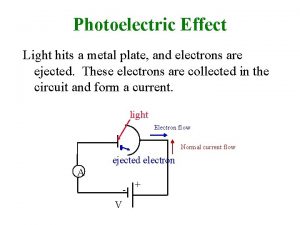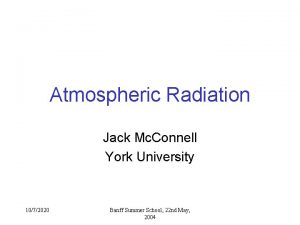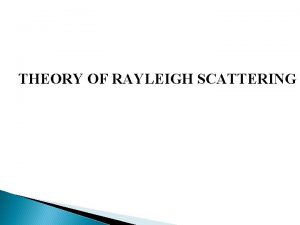Quantum Description of Scattering This is a tutorial








- Slides: 8

Quantum Description of Scattering • This is a tutorial on the quantum mechanical description of the (unpolarized) scattering process: we are NOT deriving these results, just going over them • The wave function (“amplitude”) consists of two parts: – Incident plane wave corresponding to the beam – Outgoing scattered wave with amplitude that decays as 1/r (so that the probability density falls as 1/r 2 (as it should) • The overall wave function is the sum of the two, but the outgoing • Here the BOLD characters represent vectors and k’ represent (divided by ) the momentum of the projectile particle before and after the scattering.

Interpretation of the wave function • The incident and scattered “parts” of the wave function are f(r) = and fscat(r) = • The probability flux for a wave function y(r) is given by: • So that the incident and scattered flux are: • The differential cross-section is given by the ratio and so

Momentum Transfer and Scattering Amplitude • The factor f(k, k’) can be thought of as the angular amplitude f(q) for the scattering, and [ds/d. W](q)=|f(q)|2. • As in the case of the classical scattering process, q 2, the square of the magnitude of change in the momentum q = (p’- p), is a key variable, and is related to the scattering angle by: • The scattering amplitude function f(k, k’) is given by: f(k, k’) = • Quantum Mechanically this is the matrix element for the potential V(r) between the incident wave and the overall wave function.

Integral Equation • So there is a bit of circular argument here…because in order to calculate the overall wave function y(r), one needs to know what it is already… • What this means is that y(r) is the solution to the “integral equation”: • Here f(r) is the incident wave • This integral equation is not particularly easy to solve • However, in this whole formulation, we have considered the scattering potential V(r) to be a relatively small “perturbation” to the incident wave, and should modify f(r) only slightly

Born Approximation • One strategy for solving the integral equation is to do so by “iteration”, starting with the substitution where y(r) appears inside the integral • This allows us to calculate the “ 1 st order” approximation for the scattering amplitude f(k, k’) f 1(k, k’) = • The resulting wave function y 1(r) can be plugged back into the integral to calculate the 2 nd order amplitude f 2(k, k’) • This Iterative Process is called the Born Approximation (after Max Born: ***grandfather of Olivia Newton-John***)

1 st order Born Approximation • For a Spherically symmetrical potential V(r) = where q is the magnitude of momentum change, or “transfer”, and f(k, k’) is just the Fourier transform of V(r) in variable q • Curiously, , the integral for diverges for the 1/r potential • Has anybody noticed that the total cross-section integrated from 0 to 180 degrees in q is INFINITE? • Could these two statements be related in some way • What do we do now Boss? (whose nickname is this? )

Born Approx. on Yukawa Potentuial • We use a trick: we apply the approximation on the Yukawa Potential (which can be thought to describe the potential for nucleon-nucleon strong interaction • Reason: the integral for f 1(k, k’) converges • We can recover the Rutherford scattering case by taking the limit m 0, and • The result: Note the function is in q 2: And we have:

Back to Rutherford Scattering • And taking the limit m 0, and we have: • Noting that k = p and E=p 2/2 m we rewrite the result as: • Rather amazingly, this first order Born Approximation result (ok so we had to go through the Yukawa potential) is identical to the one we got from the classical calculation!















